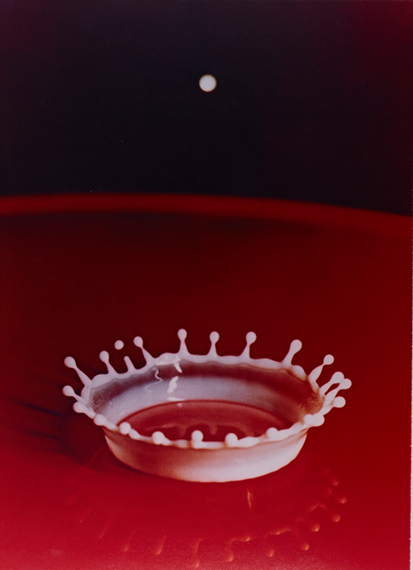
Milk Drop Coronet, 1957
Dye transfer print, printed later
46.5 x 33.8 cm (50.5 x 40.3 cm)
Harold Edgerton »
Photographs from the Gerd Sander Collection
Exhibition: 17 May – 26 Jul 2025
Fri 4 Jul

Galerie Julian Sander
Bonner Str. 82
50677 Köln
+49 (0)221-170 50 70
galerie@galeriejuliansander.de
www.galeriejuliansander.de
Wed-Fri 10-18, Sat 12-16 + b.a.
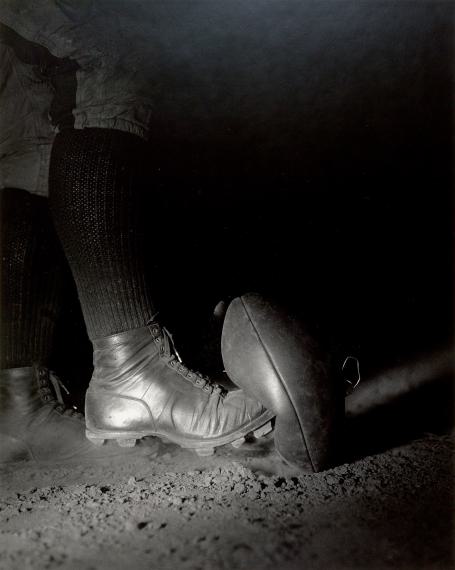
Wes Fesler kicking a Football, 1934
Gelatin silver print, printed later
45 x 35.9 cm (50.3 x 40.7 cm)
Harold Edgerton
"Photographs from the Gerd Sander Collection"
Exhibition: 17 May – 26 July, 2025
Opening: Saturday, 17 May, 11 a.m.
"I'm an electrical engineer and I work with strobe lights and circuits and make useful things.” Harold Eugene Edgerton (1903 - 1990) once responded to the question of how he defined his work with this understatement, which was as tangible as it was modest.
During his work at the Massachusetts Institute of Technology (MIT), which spanned more than six decades, he worked as an engineer, educator, researcher, entrepreneur - and as an extremely innovative photographer. Not only did he revolutionize his medium with the development of the modern electron flash. With his sensational high-speed photographs. he created some of the most famous photographic images of the 20th century. The delicate crown created by a drop falling into milk (Coronet, 1936 and Milk Drop Coronet, 1957), the projectile that smashes through an apple (Shooting the Apple, 1964), the tennis player whose motion sequence during the serve becomes visible in numerous individual moments (Gussie Moran, 1949) - they are all now firmly part of the canon of photographic history.
The photographer Edgerton - or "Papa Flash", as his long-time collaborator, the deep-sea explorer Jacques-Yves Cousteau, called him - aimed to make visible phenomena that would otherwise remain hidden to the human eye due to their high speed. While Edgerton's photographs reflect both his scientific spirit of discovery and his unerring sense of visual aesthetics, they were published early on not only in a scientific context, but also in popular magazines such as Life magazine. In addition, they quickly found their way into museum exhibitions and collections due to their visual expressiveness. As early as 1937, Beaumont Newhall presented six of his works in New York's Museum of Modern Art - a presentation that was to be followed by many more in this and other museums and galleries worldwide.
The photographs now on display at the Julian Sander Gallery, which include small-format vintage prints of lesser-known motifs in black and white as well as later, color-intensive dye transfer prints of his best-known images, are largely from the estate of Gerd Sander. Since the late 1970s, his gallery has worked closely with the photographer and with Gus Kayafas, a friend and former student of the "Doc", who was not only responsible for producing the prints, but was also entrusted with publishing the portfolios and organizing the exhibitions, thus making a significant contribution to establishing Edgerton in the art world.
A catalog will be published to accompany the exhibition.
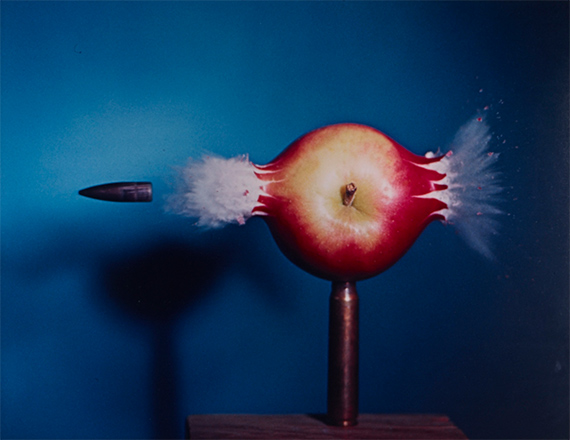
Shooting the Apple, 1964
Dye transfer print, printed later
35.8 x 45.9 cm (40.7 x 50.8 cm)
Harold Edgerton
Fotografien aus der Sammlung Gerd Sander
Ausstellung: 17. Mai bis 26. Juli 2025
Eröffnung: Samstag, 17. Mai, 11 Uhr
"Ich bin Elektroingenieur, arbeite mit Blitzlicht und Schaltkreisen und stelle nützliche Dinge her." Mit diesem ebenso handfest wie bescheiden formulierten Understatement reagierte Harold Eugene Edgerton (1903 - 1990) einst auf die Frage, wie er seine Tätigkeit definiere.
Während seiner mehr als sechs Jahrzehnte umspannenden Arbeit am Massachusetts Institute of Technology, kurz MIT, wirkte er als Ingenieur, Pädagoge, Forscher, Unternehmer – und als äußerst innovativer Fotograf, der mit der Entwicklung des modernen Elektronenblitzes sein Medium revolutionierte und mit seinen sensationellen Hochgeschwindigkeitsaufnahmen einige der berühmtesten fotografischen Bilder des 20. Jahrhunderts schuf: Die feingliedrige Krone, die von einem in Milch fallenden Tropfen erzeugt wird (Coronet, 1936 und Milk Drop Coronet, 1957), das Projektil, das einen Apfel durchschlägt (Shooting the Apple, 1964), der Tennisspieler, dessen Bewegungsablauf beim Aufschlag in zahlreichen Einzelmomenten sichtbar wird (Gussie Moran, 1949) - sie alle gehören heute fest zum Kanon der Fotogeschichte.
Jene Phänomene sichtbar zu machen, die dem menschlichen Auge aufgrund ihrer hohen Geschwindigkeit sonst verborgen bleiben, darin bestand das Anliegen des Fotografen Edgerton – oder "Papa Flash", wie ihn sein langjähriger Kooperationspartner, der Tiefseeforscher Jacques-Yves Cousteau, nannte. Kommen in Edgertons Aufnahmen sein wissenschaftlicher Entdeckergeist und sein untrügliches Gespür für Bildästhetik gleichermaßen zum Tragen, so wurden sie früh nicht nur im wissenschaftlichen Kontext, sondern auch in populären Zeitschriften wie dem LIFE Magazin publiziert. Darüber hinaus fanden sie aufgrund ihrer visuellen Ausdruckskraft schnell ihren Weg in museale Ausstellungen und Sammlungen. Bereits 1937 präsentierte Beaumont Newhall sechs seiner Werke im New Yorker Museum of Modern Art – eine Präsentation, der viele weitere in diesem und anderen Museen und Galerien weltweit folgen sollten.
Die nun in der Galerie Julian Sander ausgestellten Fotografien, zu denen kleinformatigere Vintage-Abzüge unbekannterer Motive in Schwarz-Weiß ebenso gehören wie später entstandene, farbintensive Dye Tranfer Prints seiner bekanntesten Bilder, stammen in weiten Teilen aus dem Nachlass Gerd Sanders. Seit den späten 1970er Jahren arbeitete seine Galerie eng mit dem Fotografen bzw. mit Gus Kayafas zusammen, einem Freund und ehemaligen Studenten des "Doc", der nicht nur für die Erstellung der Abzüge zuständig war, sondern darüber hinaus mit der Herausgabe der Portfolios sowie der Organisation der Ausstellungstätigkeit betraut war und damit ganz wesentlich zur Etablierung Edgertons in der Kunstwelt beitrug.
Zur Ausstellung erscheint ein Katalog.
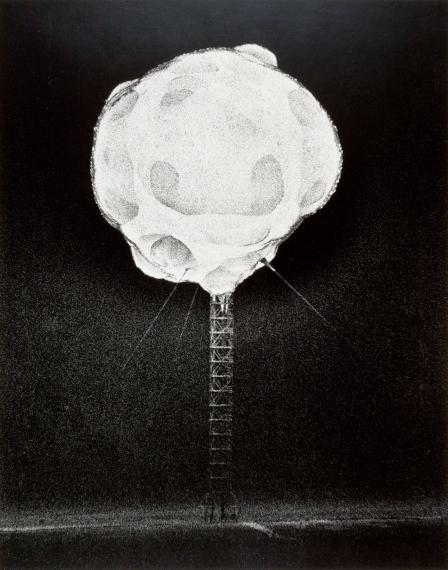
Atomic Bomb Explosion, late 1940s
Gelatin silver print, printed later
46 x 36.3 cm (50.8 x 40.7 cm)
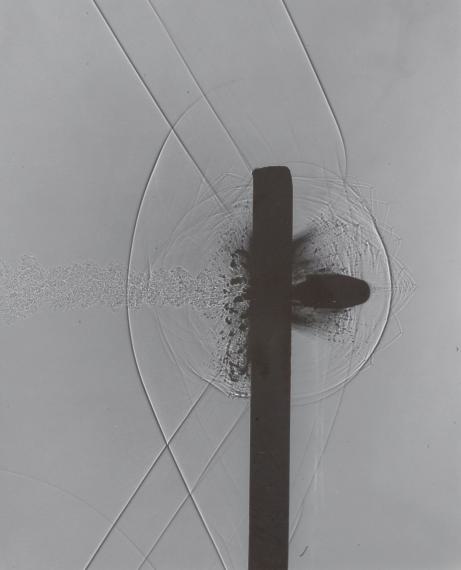
Bullet through Rubber, c. 1971
Vintage ferrotyped gelatin silver print
24.7 x 20 cm (25.4 x 20.7 cm)